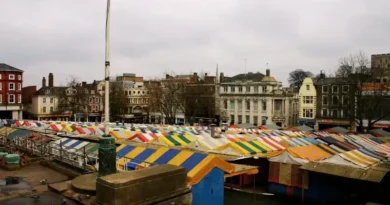Restoration of Windsor Castle after Devastating Fire in 1992
I. Introduction
Windsor Castle is the oldest and largest occupied castle in the world and has been the official residence of British monarchs for over 900 years. It is a complex and historic building with a rich architectural heritage.
In 1992, a devastating fire broke out in the castle, causing extensive damage to the State Apartments, Round Tower, and Private Chapel. The fire was a major national tragedy, and the Queen was determined to restore the castle to its former glory.
II. Restoration of Windsor Castle after Devastating in Fire 1992
A. The Aftermath

In the aftermath of the fire, the Royal Household appointed a team of experts to assess the damage and develop a restoration plan. The team included architects, engineers, historians, and conservators.
The first step was to assess the damage to the castle’s fabric and structure. The fire had caused significant damage to the roofs, floors, and walls of many of the State Apartments. The Round Tower had also been severely damaged, and the Private Chapel had been destroyed.
Once the damage had been assessed, the team began to develop a restoration plan. The plan was based on the following principles:
- To restore the castle to its former appearance, using traditional materials and techniques
- To preserve the castle’s historic integrity
- To complete the restoration as quickly as possible without compromising on quality
B. The Restoration Process

The restoration of Windsor Castle was a complex and challenging project. The scale of the damage was immense, and the team had to work quickly to avoid further damage to the castle’s fabric.
The first step was to stabilize the damaged areas of the castle. This involved removing the damaged roofs and floors and supporting the walls. Once the castle was stabilized, the team began to repair the damaged fabric.
The State Apartments were among the most badly damaged areas of the castle. The fire had destroyed the roofs, floors, and interior decoration. The team had to carefully repair the damaged walls and ceilings and reinstate the original plasterwork and woodwork.
The Round Tower was also severely damaged by the fire. The team had to carefully rebuild the tower’s roof and upper floors and repair the damaged stonework.
The fire completely destroyed the Private Chapel. The team had to design and build a new chapel while remaining faithful to the original design.
C. Funding and Cost Estimations
Initially, there were concerns that the restoration of the castle would cost £60 million. However, the final cost amounted to £36.5 million (equivalent to £62 million in 2019), and it was estimated that drying out the castle would take ten years.
D. Financial Measures and Donations
Royal palaces like Windsor Castle, which are in use, are too valuable to be insured. Additionally, items in the Royal Collection are not insured against loss. Coutts, the Queen’s Bank, established an independent trust for private donations on February 16, 1993, to cover the restoration expenses.
On April 29, 1993, it was announced that 70% of the restoration cost would be covered by charging the public for access to the castle precincts and £8 for admission to Buckingham Palace for the following five years. Queen Elizabeth II contributed £2 million from her funds. She agreed to start paying income tax in 1993, making her the first British monarch to do so since the 1930s.
E. Planning the Restoration

The details of the restoration project were disclosed on June 7, 1994. The Royal Household chose the architectural firm Donald Insall Associates to oversee the restoration, with Sidell Gibson responsible for reconstructing St George’s Hall and designing the new Lantern Lobby and Private Chapel.
Over half of the damaged and destroyed rooms, including the State and Octagon dining rooms, were to be restored to their original state. New designs were planned for the St George’s Hall ceiling, with steel reinforcing beams in the roof, the East Screen, the Queen’s Private Chapel, and the Stuart and Holbein Rooms. However, only the Queen’s Private Chapel and several modern rooms would be restored in a modern style.
F. Restoration Committee and Architectural Vision
Designs were submitted to a Restoration Committee by Prince Philip, Duke of Edinburgh, and a deputy chaired by Charles, Prince of Wales. Committee members included Sir Hayden Phillips (Permanent Secretary of the Department of National Heritage), Frank Duffy (President of the Royal Institute of British Architects), St John-Stevas, Lord St John of Fawsley (Chairman of the Royal Fine Art Commission), David Ogilvy, 13th Earl of Airlie (Lord Chamberlain), Norman Sir Jocelyn Stevens (Chairman of English Heritage), and three senior palace officials.
The fire, although devastating, provided an opportunity for significant new architectural work. While criticized by some for a perceived lack of imagination, the architects believed that, given the building’s history and surviving structure, the new work had to be in a Gothic style.
G. Execution and Architectural Details
The state dining room‘s gilded sideboard, an impressive 19 feet in length and made from rare rosewood and oak, was originally designed by Augustus Pugin in the 19th century. It had to be recreated by N.E.J. Stevenson, a company based in Rugby, using only photographs and descriptions.
The Queen approved new designs for St George’s Hall and the Queen’s Private Chapel on January 24, 1995. Designed by architect Giles Downes, the new roof for St George’s Hall has a hammer-beam ceiling. The new chapel and adjoining cloisters were realigned to create a processional route from the private apartments through an octagonal vestibule into St George’s Hall.
Downes’s new roof, the largest green-oak structure built since the Middle Ages, is adorned with brightly coloured shields celebrating the heraldic element of the Order of the Garter, with the design aiming to create the illusion of added height through the Gothic woodwork along the ceiling. Commentators have noted that Downes’s work goes a long way in compensating for the originally flawed dimensions of the hall. The Lantern Lobby features oak columns forming a vaulted ceiling, imitating an arum lily.
H. Progress and Completion

The first stage of the structural restoration was completed in May 1996, with the fitting out, originally planned for spring 1998, taking place on November 17, 1997. The Queen hosted a reception in the newly restored hall for the architects and building contractors involved. Heritage management software was utilized in the restoration of Windsor Castle
III. New Technologies Used in the Restoration of Windsor Castle
The restoration of Windsor Castle after the fire of 1992 was a complex and challenging project. It required various new technologies to restore the castle to its former glory while preserving its historical integrity.
A. Laser Scanning
Laser scanning was one of the most important new technologies to restore Windsor Castle. Laser scanning is a process that uses laser light to create a three-dimensional model of an object. The laser scanner emits a beam of light that hits the object and bounces back. The scanner then measures the time it takes for the light to bounce back, which allows it to create a precise map of the object’s surface.
Laser scanning was used to create a detailed 3D model of Windsor Castle. This model was used to help the restoration team plan the work and to ensure that the castle was restored to its original dimensions. The model was also used to create computer simulations of the fire, which helped the team to understand how the fire spread and to identify areas that were particularly vulnerable to damage.
B. Digital Photography
Digital photography was another important new technology used to restore Windsor Castle. Digital photography allowed the restoration team to document the damage to the castle in great detail. The team took thousands of photographs of the castle before and after the fire. These photographs were used to record the damage and track the progress of the restoration work.
Digital photography was also used to create virtual tours of the castle. These virtual tours allowed people worldwide to see the castle and the restoration work in progress.
C. Computer-aided Design (CAD)
Computer-aided design (CAD) was used to design new architectural features for the castle, such as replacement windows and doors. CAD is a software program that allows users to create three-dimensional models of objects. The restoration team used CAD to design new architectural features faithful to the castle’s original design while meeting modern safety and security standards.
D. Drone Technology
Drone technology was used to inspect the castle’s roof and exterior walls for damage. Drones are small, crewless aerial vehicles that can be equipped with cameras and other sensors. The restoration team used drones to take high-resolution photographs and videos of the castle’s roof and exterior walls. These photographs and videos were used to identify areas of damage that were not visible from the ground.
E. Heritage Management Software
Heritage management software was used to manage the restoration project. This software allowed the restoration team to track the progress of the work, manage budgets, and communicate with the public. Heritage management software also helped the team ensure that the restoration work was carried out in a way compatible with the castle’s historical integrity.
These new technologies were essential to the successful restoration of Windsor Castle. These technologies allowed the restoration team to work more efficiently and achieve a higher work standard. They also helped to raise public awareness of the restoration project and generate support for the work.
IV. The Legacy of the Restoration

The restoration of Windsor Castle was a major national undertaking, and it has had a lasting legacy. The castle is a national symbol, and its restoration was seen as a sign of hope and resilience in the fire’s aftermath.
The restoration has also significantly impacted the local community. The castle is a major tourist attraction, and the restoration has helped to boost the local economy.
V. Conclusion
The restoration of Windsor Castle is a testament to the human spirit. In the aftermath of a devastating fire, the British people came together to restore one of their most cherished national symbols. The restoration was completed on time and within budget, preserving the castle’s historic integrity for future generations.
The restoration of Windsor Castle is also a model for other heritage projects. The team used innovative techniques to repair the damaged fabric of the castle, and they worked closely with the community to ensure the restoration was successful.
The restoration of Windsor Castle reminds us of the importance of investing in our cultural heritage. Our heritage buildings and monuments are vital to our national identity and deserve to be preserved for future generations.
VI. FAQs
1. How did laser scanning technology play a crucial role in restoring Windsor Castle after the 1992 fire, and what specific applications were used in the process?
Laser scanning technology was crucial in restoring Windsor Castle after the 1992 fire in several ways.
a) Damage assessment:
One of the restoration team’s first tasks was to assess the damage caused by the fire. This was a complex and challenging task, as the fire had damaged a significant portion of the castle. Laser scanning technology was used to create accurate 3D models of the damaged areas of the castle. These models assessed the damage’s extent and developed a restoration plan.
b) Monitoring and surveying:
Laser scanning technology was also used to monitor and survey the castle’s condition during and after restoration. This was important to ensure the restoration progressed on schedule and identify potential problems early on.
c) Design and fabrication:
Laser scanning technology was also used to design and fabricate new components for the castle. This was particularly useful for restoring the Round Tower, which had been severely damaged by the fire. The laser scanning data was used to create accurate 3D models of the tower, which were then used to design and fabricate new stone blocks and other components.
d) Quality control:
Laser scanning technology was also used for quality control purposes. Once the new components had been fabricated, laser scanning was used to ensure they met the required specifications.
Specifically, the following laser scanning applications were used in the restoration of Windsor Castle:
- Terrestrial laser scanning (TLS): TLS scanners create 3D models of large objects or areas. They were used to create 3D models of Windsor Castle’s exterior and interior, both before and after the fire.
- Mobile laser scanning (MLS): MLS scanners are mounted on vehicles or other platforms and can quickly and efficiently create 3D models of large areas. They were used to create 3D models of Windsor Castle’s grounds and surrounding area.
- Close-range laser scanning (CLS): CLS scanners create high-resolution 3D models of small objects or areas, such as architectural features such as fireplaces and statues.
The use of laser scanning technology in the restoration of Windsor Castle was a major innovation. It allowed the restoration team to assess the damage, monitor the progress of the restoration, and design and fabricate new components with greater accuracy and efficiency. The successful restoration of Windsor Castle is a testament to the power of laser scanning technology.
2. What was the lasting impact of the Windsor Castle restoration on the local community and the national identity, and how did the use of new technologies like drones and digital photography contribute to its success?
The restoration of Windsor Castle had a lasting impact on the local community and national identity in several ways.
a) Local community:
The restoration project created jobs, boosted the local economy, and supported local businesses, such as hotels, restaurants, and shops.
The restoration also positively impacted the local community’s pride and identity. Windsor Castle is a local landmark and a source of great pride for the community. The restoration of the castle helped strengthen the community’s sense of identity and boosted morale.
b) National identity:
Windsor Castle is a national symbol, and its restoration was seen as a sign of hope and resilience in the aftermath of the fire. The restoration also helped to strengthen the national identity by preserving and promoting the country’s cultural heritage.
New technologies:
New technologies, such as drones and digital photography, played a crucial role in the success of the Windsor Castle restoration project.
Drones were used to survey the damage caused by the fire and monitor the restoration’s progress. This allowed the restoration team to assess the damage quickly and efficiently and identify potential problems early on.
Digital photography was used to document the damage caused by the fire, monitor the restoration’s progress, and create a photographic archive of the castle. This documentation was essential for assessing the damage, planning the restoration, and monitoring the progress of the work.
The use of new technologies was a major innovation in the restoration of Windsor Castle. It allowed the restoration team to work more efficiently and effectively and helped ensure the project’s success.
Overall, the restoration of Windsor Castle had a positive impact on the local community and national identity. The use of new technologies, such as drones and digital photography, played a crucial role in the project’s success.
The use of new technologies in restoring Windsor Castle helped ensure the project’s success. It also positively impacted the local community and national identity.










Comments are closed.